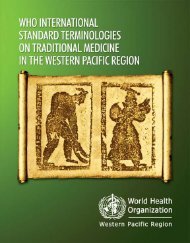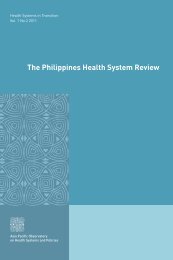Download pdf, 989kb - WHO Western Pacific Region - World Health ...
Download pdf, 989kb - WHO Western Pacific Region - World Health ...
Download pdf, 989kb - WHO Western Pacific Region - World Health ...
Create successful ePaper yourself
Turn your PDF publications into a flip-book with our unique Google optimized e-Paper software.
Sexual and Reproductive <strong>Health</strong> of Adolescents and Youths in Malaysia<br />
contraceptives or that they found<br />
contraceptives too difficult to use. One<br />
out of the two students in the Melaka<br />
study reported using contraception.<br />
A concern, therefore, is that most sexual<br />
encounters are unsafe, with no<br />
protection against unwanted pregnancies<br />
or STI. From the various data sources, it<br />
is quite fair to estimate that that is the<br />
case for about 10%-20% of young<br />
people, and it appears that the issue of<br />
teen sexuality is not being adequately<br />
addressed by the relevant sectors.<br />
Contraceptive use is a sensitive issue for<br />
which accurate information is not easy<br />
to obtain. Indeed the only reliable<br />
information is that for married women,<br />
for which the trend over time is very<br />
encouraging. Of course married couples<br />
practice contraception mainly for child<br />
spacing and family size limitation. The<br />
very few studies on unmarried young<br />
people suggest a relatively low usage rate.<br />
The condom is the most common<br />
method, probably due to easier<br />
availability, being available at retail outlets,<br />
and to increased awareness about safe<br />
sex since the spread of the AIDS<br />
epidemic. There were some respondents<br />
who cited “too difficult to use” as the<br />
reason for not using contraceptives.<br />
unmarried people, education on using<br />
various methods is carried out. In<br />
Malaysia, this is clearly out of the<br />
question. This review gives ample<br />
evidence that young people know about<br />
family planning, yet many of them do<br />
not access such services, citing reasons<br />
like being unprepared. The barriers to<br />
service utilization may also be service<br />
policies affecting family planning<br />
services in the country. Generally family<br />
planning is promoted for health reasons,<br />
with emphasis on child spacing and<br />
avoidance of risky pregnancies, and<br />
clinical services in the country’s public<br />
sector are targeted at married couples.<br />
Those who are not married usually<br />
obtain services from the private sector<br />
and FPA clinics, while hormonal pills can<br />
be obtained from pharmacy retail outlets<br />
and condoms from general goods<br />
outlets. The FFPAM and other<br />
nongovernmental organizations are<br />
increasingly advocating for the<br />
promotion of sexual and reproductive<br />
health of adolescents, primarily through<br />
prevention education and also through<br />
provision of selected clinical services.<br />
However, it is feared that such services<br />
are unlikely to be utilized fully in view<br />
of the social sensitivity and religious<br />
sanctions against many matters related<br />
to sexuality.<br />
34<br />
In countries where policies do not<br />
disallow or criminalize contraception in

















